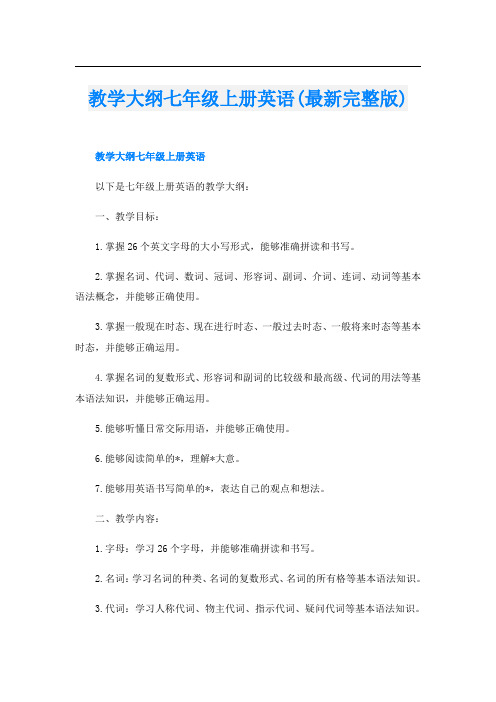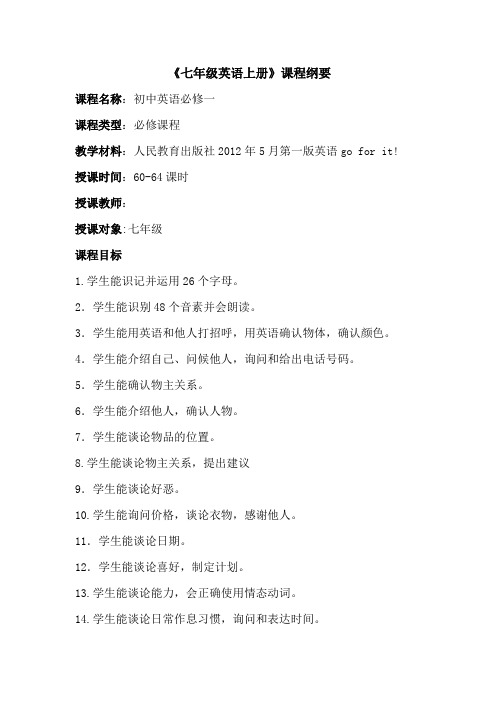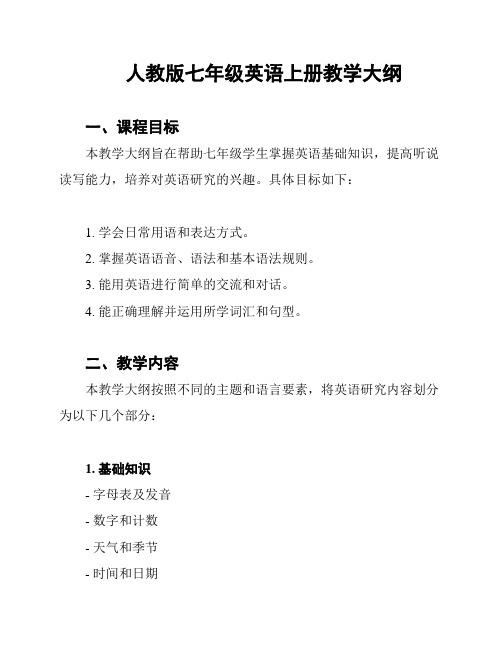七年级英语上册课程纲要
七年级上册英语课程纲要

七年级上册英语课程纲要集团档案编码:[YTTR-YTPT28-YTNTL98-UYTYNN08]七年级上册英语课程纲要◆课程名称:七年级英语◆课程类型:必修课程◆教学材料:人教版2012年5月第1版《七年级英语》◆授课时间:60课时◆授课对象:义务教育阶段七年级学生◆设计:一、学生、教材及其他资源背景分析从学生方面看:七年级新生已具备了一定的英语基础。
他们感知了英语是一门什么样的语言,学习了字母、音标、600多个三会以上的词和词组、数百个基本句子,接触到了一些语法现象。
不少学生对英语产生了兴趣,养成了大胆发言、规范书写、依据读音记单词、独立完成学习任务等良好的学习习惯,具备了一定的听说读写的语言技能。
但由于教学条件、教学管理、师资水平、学生智力等多方面的原因,学生在小学期间的英语学习中发展极不平衡,分化特别严重。
从学习内容看:本册共十二单元,其中前面1--3单元为预备单元。
后面9单元为正式教学单元。
自初中英语教材开始改革以来,专门设置了预备单元,使没有英语学习基础的学生能更好地使用这套教材。
但是,这几个预备单元的内容和小学四年的英语教材相比,还是显得单薄。
所以,我们在教学中,要注意根据教材内容,对相关的小学英语知识进行适当的、有计划的、系统的补充,尤其是词汇方面的补充。
这就要求我们要了解小学英语和中学英语的知识结构体系两者之间的联系和相互渗透的程度。
这样,我们才能把该补充的内容在适当的时候进行补充,才能使这种补充具有科学性和系统性。
因此,本期一方面应继续加强基础知识的学习,把各个知识点真正落实到位,另一方面,还要通过学生的自主回忆、自主整理、合作交流等方式,引导学生对小学所学的内容进行系统的归纳整理,通过教学目标的有效落实和课堂教学的有效启发,发展学生的总结概括能力和利用内容全面的梳理和概括,努力提高学习的学习质量。
二、课程目标通过本学期的学习,教师要要引领学生:1、通过体验和参与,对英语学习表现出积极性和初步的自信心。
教学大纲七年级上册英语(最新完整版)

教学大纲七年级上册英语(最新完整版)教学大纲七年级上册英语以下是七年级上册英语的教学大纲:一、教学目标:1.掌握26个英文字母的大小写形式,能够准确拼读和书写。
2.掌握名词、代词、数词、冠词、形容词、副词、介词、连词、动词等基本语法概念,并能够正确使用。
3.掌握一般现在时态、现在进行时态、一般过去时态、一般将来时态等基本时态,并能够正确运用。
4.掌握名词的复数形式、形容词和副词的比较级和最高级、代词的用法等基本语法知识,并能够正确运用。
5.能够听懂日常交际用语,并能够正确使用。
6.能够阅读简单的*,理解*大意。
7.能够用英语书写简单的*,表达自己的观点和想法。
二、教学内容:1.字母:学习26个字母,并能够准确拼读和书写。
2.名词:学习名词的种类、名词的复数形式、名词的所有格等基本语法知识。
3.代词:学习人称代词、物主代词、指示代词、疑问代词等基本语法知识。
4.数词:学习基数词和序数词的用法,并能够进行简单的计算。
5.冠词:学习定冠词和不定冠词的用法。
6.形容词和副词:学习形容词和副词的基本用法,并能够进行比较级和最高级的比较。
7.介词:学习常用介词的用法,并能够进行简单的介词搭配。
8.连词:学习并列连词的用法,并能够进行简单的句子连接。
9.动词:学习动词的基本用法,并能够进行时态和语态的变化。
10.日常交际用语:学习常用的日常交际用语,并能够正确使用。
11.阅读理解:阅读简单的*,理解*大意。
12.写作:用英语书写简单的*,表达自己的观点和想法。
三、教学重点和难点:1.字母的教学重点是字母的大小写形式和发音,难点是拼读和书写。
2.名词的教学重点是名词的种类和复数形式,难点是名词的所有格和单复数形式。
3.代词的教学重点是代词的种类和使用方法,难点是疑问代词和指示代词的区别。
4.数词的教学重点是基数词和序数词的用法,难点是简单的计算。
5.冠词的教学重点是定冠词和不定冠词的用法,难点是冠词的省略和添加。
七年级上英语课程纲要

(三)教、学的方式:
1、教学方式:充分利用便捷的班班通系统,采用“任务型” 教学方式,培养学生的综合能力。主要有: 1.直观教学 2.媒体辅助 3.表演 4.模拟训练 5.社会实践 2、学习方式: (1)集体 (2)分组 (3)教师设计、组织、主持 (4)学生设计、组织、主持 3.拓展 课外拓展性练习:习题练习以课外知识拓展搜集、练习和 记忆,利用多媒体学习和了解与课文内容相关的知识。
二、课程内容
新修订的教材一方面保持原有教材的特色:比如采 用任务型教学模式,融汇话题,交际功能和语言结构, 帮助学生发展语言运用能力。另一方面体现和落实课程 标准的基本理念和教学要求,比如体现英语教学的工具 性和人文性的结合的要求,突出一人为本的教学思想, 在培养学生语言运用能力的同时,还培养学生的学习策 略,丰富学生的合作能力和创新能力,提高学生的综合 素质。从内容量的方面看,新教材比老教材少了三个单 元,词汇量总体也有所减少,为学生减轻了学习英语的 负担,增强了英语的实用性。
四、课程评价
1、评价指标:
1 )过程性评价成绩(30%) (1)学生每次作业情况10% ,记录在作业评价本里。 (2)学生每单元的单词默写情况10% ,记录在词汇积累默写记 录本中。 (3)学生的每月表现10%,记录在班级量化管理表中。
(2)结果性评价(70%): 期中期末测试。 2、评价结果的处理: (1)力争过程性评价和结果性评价达标率达到85%,对达不到 要求的学生采取生生互助、教师谈心、作业面批面改等方式予以 指导帮助。 (2)教师要主动做好学生问卷调查,及时反思和改进教学。 (3)学期评价成绩50分以上为合格,不足50分为不合格。成绩 不合格需要在寒假之后的第一周补考
1.整本书共有12个单元,其中包含了三个单 元的预备篇(Starter Unit1-3)和正式篇的 九个单元。 2.每个单元分为三个部分,即:Section A, Section B和 Self check. 3. 本套教材的话题,如下:
七年级英语课程纲要

《七年级英语上册》课程纲要课程名称:初中英语必修一课程类型:必修课程教学材料:人民教育出版社2012年5月第一版英语go for it! 授课时间:60-64课时授课教师:授课对象:七年级课程目标1.学生能识记并运用26个字母。
2.学生能识别48个音素并会朗读。
3.学生能用英语和他人打招呼,用英语确认物体,确认颜色。
4.学生能介绍自己、问候他人,询问和给出电话号码。
5.学生能确认物主关系。
6.学生能介绍他人,确认人物。
7.学生能谈论物品的位置。
8.学生能谈论物主关系,提出建议9.学生能谈论好恶。
10.学生能询问价格,谈论衣物,感谢他人。
11.学生能谈论日期。
12.学生能谈论喜好,制定计划。
13.学生能谈论能力,会正确使用情态动词。
14.学生能谈论日常作息习惯,询问和表达时间。
15.学生能谈论喜好,表述理由。
课程内容根据《义务教育课程标准实验教科书》的要求,采用人民教育出版社的《新目标》课程内容进行教学。
其课程内容包括:Unit 1:My name’s Gina.(5课时)Unit 2:Is this your pencil? (5课时)Unit 3: This is my sister. (5课时)Unit 4:Where’s my backpack? (5课时)Unit 5: Do you have a soccer ball? (5课时)Unit 6: Do you like bananas? (5课时)Unit 7: How much are these pants? (5课时)Unit 8: When is your birthday? (5课时)Unit 9: Do you want to go to a movie? (5课时)Unit 10: Can you play the guitar? (5课时)Unit 11: What time do you go to school? (5课时)Unit 12: My favorite subject is science. (5课时)课程实施:1、课程资源教材:对教材进行校本的二度开发,根据学生的实际情况进行适当的增减和调速。
2022-2023学年七年级英语上册教学大纲(人教版)

2022-2023学年七年级英语上册教学大纲
(人教版)
教学目标
1. 培养学生对英语的兴趣和研究动力。
2. 培养学生基本的英语听、说、读、写能力。
3. 培养学生的团队合作精神和社交能力。
4. 让学生了解和尊重不同文化背景下的差异。
教学内容
1. 单元主题
2. 词汇与语法
3. 听力与口语
4. 阅读与写作
5. 研究策略
评估方法
1. 学生平时表现:听说读写能力、课堂参与度。
2. 课堂小测验:单词拼写、语法填空。
3. 期中考试:听力、口语、阅读、写作。
4. 期末考试:听力、口语、阅读、写作。
教学资源
1. 教材:《人教版七年级英语上册》。
2. 录音资源:教材配套的听力材料。
3. 研究工具:课堂教具、多媒体设备。
教学活动安排
1. 每周三节英语课,每节40分钟。
2. 每节课包括听力、口语、阅读和写作练。
备注
本教学大纲仅作为教学参考,具体教学内容和安排根据实际情况调整和优化。
以上教学大纲内容来自人教版七年级英语上册教材,教师可根据学生的实际情况进行适当调整和拓展。
人教版七年级英语上册教学大纲

人教版七年级英语上册教学大纲一、课程目标本教学大纲旨在帮助七年级学生掌握英语基础知识,提高听说读写能力,培养对英语研究的兴趣。
具体目标如下:1. 学会日常用语和表达方式。
2. 掌握英语语音、语法和基本语法规则。
3. 能用英语进行简单的交流和对话。
4. 能正确理解并运用所学词汇和句型。
二、教学内容本教学大纲按照不同的主题和语言要素,将英语研究内容划分为以下几个部分:1. 基础知识- 字母表及发音- 数字和计数- 天气和季节- 时间和日期2. 日常用语- 问候和介绍- 询问和回答个人信息- 表达喜好和不喜欢- 提出请求和邀请3. 语法和句型- 简单的肯定和否定句- 一般疑问句及回答- 情态动词的基本用法- 物主代词的使用4. 阅读理解- 短文阅读和理解- 识别关键词和信息- 回答问题和表达观点三、教学方法为了培养学生的听说读写能力,我们将采用以下教学方法:1. 多媒体教学:使用PPT、录音等多媒体手段展示和讲解课程内容。
2. 分组活动:组织学生进行小组讨论、对话和角色扮演,提高口语交流能力。
3. 集体讨论:引导学生参与整体课堂讨论,培养阅读和写作能力。
4. 个性化辅导:根据学生的不同程度和需求,进行个别辅导和指导。
四、教学评估为了及时了解学生的研究情况和评估教学效果,我们将采用以下评估方式:1. 课堂练:通过课堂练测试学生对所学知识和技能的掌握程度。
2. 作业评定:对学生布置的作业进行评定,检查学生的阅读和写作能力。
3. 课后测试:定期进行课后测试,检验学生对前几节课的掌握程度。
五、教学资源本教学大纲所需的教学资源包括教材、多媒体设备、练册等。
学校应提供充足的资源,并保证设备正常运行。
以上即为《人教版七年级英语上册教学大纲》的内容,希望能帮助学生们更好地学习英语。
+Unit+3+My+School+课程方案大纲 人教版(2024)七年级英语上册++
人教版 PEP 七年级上册 Unit 3 My School 课程方案大纲一、设计原则1.以学生为中心:关注学生的兴趣和需求,鼓励学生积极参与课堂活动,培养学生的自主学习能力。
2.情境性原则:创设真实的校园情境,让学生在情境中学习和运用语言,增强语言的实际运用能力。
3.综合性原则:注重语言知识、技能、情感、文化等方面的综合培养,促进学生的全面发展。
4.渐进性原则:教学内容和活动的安排遵循由易到难、由浅入深的原则,逐步提升学生的语言能力。
二、课程目标1.语言知识目标o掌握与学校相关的词汇,如 school, hall, classroom, office, gym, library 等。
o学会用英语描述学校的各个场所及其位置关系。
o掌握 there be 句型的用法。
2.语言技能目标o能够用英语准确地描述学校的布局和设施。
o能听懂关于学校的对话和短文,并能获取关键信息。
o能正确运用所学词汇和句型进行书面表达,介绍自己的学校。
3.情感态度目标o培养学生对学校的热爱和归属感。
o增强学生的团队合作意识和集体荣誉感。
4.学习策略目标o学会运用地图、图片等资源辅助学习。
o积极参与小组合作学习,与同学共同完成任务。
5.文化意识目标o了解不同国家和地区学校的差异,拓宽国际视野。
三、核心素养1.语言能力:通过学习本单元的词汇、句型和语法,学生能够提高英语语言的表达和理解能力,用英语准确地描述学校的各个场所。
2.文化意识:了解不同文化中学校的特点和差异,增进对多元文化的理解和尊重。
3.思维品质:在学习和讨论学校话题的过程中,培养学生的空间思维、逻辑思维和批判性思维能力。
4.学习能力:引导学生掌握有效的学习方法,如预习、复习、归纳总结等,提高自主学习能力和合作学习能力。
四、课程结构变化1.模块化设计o本单元分为 Section A 和 Section B 两部分,每个部分又包含Listening, Speaking, Reading 和 Writing 等模块,使教学内容更加系统和有条理。
七年级上册课程纲要
《七年级英语上册》课程纲要课程名称七年级英语上册课程类型义务教育教科书教学材料人民教育出版社《七年级英语上册》授课时间17周授课教师许忭红授课对象七年级四班、五班学生课程目标1学生通过体验和参与对英语学习表现出积极性和初步的自信心.2学生通过听说训练能听懂有关熟悉话题的语段和简短的故事.3学生通过合作学习能与教师或同学就熟悉的话题交换信息。
4学生通过教材范例学习能参照范例或借助图片写出简单的句子。
5学生在与同学合作学习的过程中,通过情景设置体验合作能参与简单的角色扮演等活动。
课程内容Starter Unit 1-3 内容为26个英文字母和基本日常用语。
Using “Good morning Good afternoon Good evening and How are you?”to greet ing “What is this in English? It is a map”and so on to identify ing “What color is it? It is red”to identify colors.重难点为A E I O U 五个元音字母和含有五个元音字母发音的字母的分类。
Unit 1 My name's Gina 用含有Be动词作为系动词和助动词的句子来介绍自己你、问候他人询问和给出电话号码:What is your name? What is your telephone?.Unit 2 This is my sister用含有Be动词作为系动词和助动词的句子介绍他人;This is my sister .Is that your brother?.Unit 3 Is this your pencil?用含有Be动词作为系动词和助动词和有物主代词的句子确认物主关系:Is this your pencil?Yes ,it is .No ,it isn’t.Unit 4 Where's my schoolbag? 用含有Be动词作为系动词和助动词以及Where的句子谈论物品的位置:Where is my backpack?It’s in\ under \on the chair.Unit 5 Do you have a soccer ball?用含有DO动词作为实意动词和助动词的句子来谈论物主关系;提出建议:“Do you have a soccer ball? Does he have a soccer ball? Yes ,I do .No ,I don’t .Yes,he does.No ,he doesn’tUnit 6 Do you like bananas?用含有do动词作为实意动词和助动词的句子来谈论好恶:Do you like bananas?Yes ,I do .No ,I don’t.Unit 7 How much are these socks?用含有How much和Be动词作为系动词和助动词的句子来询问价格;谈论衣物;感谢他人:“How much are these pants? They are 35 dollars"进行购物的情景交际.Unit 8 When is your birthday?用含有When 和Be动词作为系动词和助动词的句子谈论日期:When is your birthday?Unit 9 My favourite subject is science用含有Be动词作为系动词和助动词和do动词以及favorite的句子来谈论喜好,表述理由:“What is your favorite subject?Myfavorite subject is science. Why do you like math?Because it’s interesting.课程实施建议一课程资源1教材:对教材内容进行适当的补充和扩展,可以替换一些活动内容。
初中英语课程纲要(七年级上)
初中英语必修课课程纲要(七年级上)第三课时Section B1a—2c+4a1. 通过问答及听力训练谈论自己及他人做某事持续多长时间,训练学生的听说能力。
2. 谈论爱好,学习及区分现在完成进行时,一般过去时,现在进行时。
第四课时Section B3a—3b+self check1.阅读谈论人们业余爱好及人们收藏某物多长时间的文章。
2.学会描述自己及他人的业余爱好。
3.设计适合学生实际的话题及问题,复习本单元语法及重点词汇、句型。
第五/六课时Reading1. 略读课文,快速浏览寻找所需的细节信息.2. 通过让学生做对、错练习以检测学生对该篇章的理解程度。
3. 让学生自己提问、回答,给学生自主学习的时间,培养学生提问能力。
对本课的重点进一步掌握。
第七单元第一课时 SectionA1a—2c +Section A3a—41.由学生已经学习了许多动词短语,还学习过祈使句和Can you…?/Couldyou 及Could you please提出请求, 为本课的学习打下了铺垫为表达提供了语言基础。
2.创设情境,增加学生的单词储备量,通过任务型教学创造性地使用英语。
第二课时SectionB1a—2c+3a—41. 指导学生多说,多听,以巩固目标语言项目。
2.利用情景创设法、交际法引导学生学会用英文表达请求,表示歉意。
第三课时self check1.复习巩固单元内容,创设情境提高综合运用能力。
第四/五课时 Reading1.培养阅读策略,寻找“总结”或者概括每段大意的“中心句”,帮助我们获取文章的更多信息.2.通过阅读比较,了解和熟悉中西方文化中的礼节问题。
第八单元第一课时 SectionA1a—2c +Section A3a—41. 通过卡片,图片复习单词和认知实物。
2. 通过生日导入新课,学会赠送礼物的句型。
通过对课本3a 3b的学习熟练掌握本单元重点句型what should I get for sb.谈论如何赠送礼物。
初中英语课程纲要(七年级上)
初中英语课程纲要(七年级上)初中英语必修课课程纲要(七年级上)第三课时Section B1a—2c+4a1. 通过问答及听力训练谈论自己及他人做某事持续多长时间,训练学生的听说能力。
2. 谈论爱好,学习及区分现在完成进行时,一般过去时,现在进行时。
第四课时Section B3a—3b+self check1.阅读谈论人们业余爱好及人们收藏某物多长时间的文章。
2.学会描述自己及他人的业余爱好。
3.设计适合学生实际的话题及问题,复习本单元语法及重点词汇、句型。
第五/六课时Reading1. 略读课文,快速浏览寻找所需的细节信息.2. 通过让学生做对、错练习以检测学生对该篇章的理解程度。
3. 让学生自己提问、回答,给学生自主学习的时间,培养学生提问能力。
对本课的重点进一步掌握。
第七单元第一课时 SectionA1a—2c +Section A3a—41.由学生已经学习了许多动词短语,还学习过祈使句和Can you…?/Couldyou 及Could you please提出请求, 为本课的学习打下了铺垫为表达提供了语言基础。
2.创设情境,增加学生的单词储备量,通过任务型教学创造性地使用英语。
第二课时SectionB1a—2c+3a—41. 指导学生多说,多听,以巩固目标语言项目。
2.利用情景创设法、交际法引导学生学会用英文表达请求,表示歉意。
第三课时self check1.复习巩固单元内容,创设情境提高综合运用能力。
第四/五课时 Reading1.培养阅读策略,寻找“总结”或者概括每段大意的“中心句”,帮助我们获取文章的更多信息.2.通过阅读比较,了解和熟悉中西方文化中的礼节问题。
第八单元第一课时 SectionA1a—2c +Section A3a—41. 通过卡片,图片复习单词和认知实物。
2. 通过生日导入新课,学会赠送礼物的句型。
通过对课本3a 3b 的学习熟练掌握本单元重点句型what should I get for sb.谈论如何赠送礼物。
- 1、下载文档前请自行甄别文档内容的完整性,平台不提供额外的编辑、内容补充、找答案等附加服务。
- 2、"仅部分预览"的文档,不可在线预览部分如存在完整性等问题,可反馈申请退款(可完整预览的文档不适用该条件!)。
- 3、如文档侵犯您的权益,请联系客服反馈,我们会尽快为您处理(人工客服工作时间:9:00-18:30)。
初中英语课程纲要(七年级上册)●●学校名称:官渡中学●●课程类型:义务教育基础型课程●●设计团队:中牟县官渡中学七年级英语备课组●●教学材料:义务教育教科书七年级英语上册●●设计日期:2012-09-01●●适用学段:七年级上学期●●授课时间:本学期实际授课18个周,本册共12个单元,每单元六个课时54课时完成9个周,期中复习考试一个周,期末考试复习三周,机动一周。
一、学生、教材及其他资源背景分析从学生方面看:七年级新生已具备了一定的英语基础。
他们感知了英语是一门什么样的语言,学习了字母、音标、单词和词组、数十个基本句子,接触到了一些语法现象。
不少学生对英语产生了兴趣,养成了大胆发言、规范书写、依据读音记单词、独立完成学习任务等良好的学习习惯,具备了一定的听说读写的语言技能。
但由于教学条件、教学管理、师资水平、学生智力等多方面的原因,学生在小学期间的英语学习中发展极不平衡,分化特别严重。
从学习内容看:本册共十二单元,其中前面1--3 单元为预备单元。
后面1--9单元为正式教学单元。
自初中英语教材开始改革以来,专门设置了预备单元,使没有英语学习基础的学生能更好地使用这套教材。
但是,这几个预备单元的内容和小学四年的英语教材相比,还是显得单薄。
所以,我们在教学中,要注意根据教材内容,对相关的小学英语知识进行适当的、有计划的、系统的补充,尤其是词汇方面的补充。
这就要求我们要了解小学英语和中学英语的知识结构体系两者之间的联系和相互渗透的程度。
这样,我们才能把该补充的内容在适当的时候进行补充,才能使这种补充具有科学性和系统性。
因此,本期一方面应继续加强基础知识的学习,把各个知识点真正落实到位,另一方面,还要通过学生的自主回忆、自主整理、合作交流等方式,引导学生对小学所学的内容进行系统的归纳整理,通过教学目标的有效落实和课堂教学的有效启发,发展学生的总结概括能力和利用内容全面的梳理和概括,努力提高学习的学习质量。
二、课程目标通过本学期的学习,教师要要引领学生:1、通过体验和参与,对英语学习表现出积极性和初步的自信心。
2、通过听说训练,能听懂有关熟悉话题的语段和简短的故事。
3、通过合作学习,能与教师或同学就熟悉的话题交换信息。
4、通过教材范例学习,能参照范例或借助图片写出简单的句子。
5、在与同学合作学习的过程中,通过情景设置,体验合作,能参与简单的角色扮演等活动。
三、课程内容与安排:【课时1】开学英语学习探讨:解读本学期的《课程纲要》、学案的结构及使用方法。
第一模块:STARTER Unit1-3◆内容标准:为了使没有英语学习基础的学生更好地使用本套教材,预备篇包含3个单元,内容为26个英文字母和基本日常用语。
Using “Good morning Good afternoon Good evening and How are you?”to greet ing “What is this in English? It is a map”and so on to identify ing “What color is it? It is red”to identify colors.◆章节重难点:A E I O U 五个元音字母和含有五个元音字母发音的字母的分类◆教学安排:【课时2】Unit1 Sa字母A-H 的听说读写【课时3】Unit1 Sa字母A-H 的听说读写复习和“Good morning Good afternoon Good evening 的问候语【课时4】Unit1 Sb字母A-H 的听说读写复习,学习How are yo u ?I am fine.I am OK的问候语。
【课时5】Unit1 Sb字母A-H 的元音字母A E以及有发音因素和A E相同的字母和单词。
“Good morning Goodafternoon Good evening 的问候语【课时6】Unit2Sa字母I-R 的听说读写【课时7】Unit2 Sa字母I-R 的听说读写复习和“What is this in English? It is a map 的确认物体【课时8】Unit2 Sb字母I-R 的听说读写复习,学习“What is thisin English? It is a map 的确认物体和拼写单词。
【课时9】Unit2 Sb字母A-R的元音字母A E I O以及有发音因素和A E I O相同的字母和单词。
What is thisin English? It is a map 的确认物体和拼写单词。
【课时10】Unit3Sa字母S-Z的听说读写【课时11】Unit3 Sa字母S-Z 的听说读写复习和“What color i s it? It is red的辨认颜色。
【课时12】Unit3 Sb字母S-Z 的听说读写复习,学习“What color is it ? It is red 的辨认颜色和学习ABC歌曲。
【课时13】Unit3Sb字母A-Z的元音字母A E I O U以及有发音因素和A E I O U相同的字母和单词。
What color is it ? It is red 的辨认颜色和拼写完成句子。
第二模块:UNIT 1-4◆内容标准:用含有Be动词作为系动词和助动词的句子来介绍自己你、问候他人、询问和给出电话号码:“What is your name? What is your telephone number?.用含有Be动词作为系动词和助动词和有物主代词的句子确认物主关系:Is this your pencil? Yes ,it is . No ,it isn’t.用含有Be动词作为系动词和助动词的句子介绍他人;Th is is my sister .Is that your brother?.确认人物:用含有Be动词作为系动词和助动词以及Where的句子谈论物品的位置:Where is my b ackpack? It’s in\ under \on the chair.◆章节重难点:Units1-4总体重难点是be动词和何时使用am i s are.第1单元first name和family name 的区别;第2单元是句子单复数的变化·第3单元是一般疑问句简略回答和如何写公告信息;第4单元是用方位词如何表达物品位置。
◆教学安排:【课时14】Unit1 Sa 1a-2c and new words【课时15】Unit1 Sa 3a-4 and new words【课时16】Unit1 Sb 1a-2c and new words【课时17】Unit1 Sb 3a-self check【课时18】Unit2 Sa 1a-2c and new words【课时19】Unit2 Sa 3-4b【课时20】Unit2 Sb 1a-2c and new words【课时21】Unit2 Sb 3a-self check【课时22】Unit3 Sa 1a-GF and new words【课时23】Unit3 Sa 3a-4【课时24】Unit3 Sb 1-2c and new words【课时25】Unit3 Sb 3a-self check【课时26】Unit4 Sa 1a-GF and new words【课时27】Unit4 Sa 3a-4【课时28】Unit4 Sb 1a-2b and new words【课时29】Unit4 Sb 3a-self check第三模块:UNIT5-6◆内容标准:用含有DO动词作为实意动词和助动词的句子来谈论物主关系;提出建议:“Do you have a soccer ball? Do es he ha ve a s occer ball? Yes ,I do .No ,I don’t .Yes ,he does. No ,he d oesn’t用含有do动词作为实意动词和助动词的句子来谈论好恶:Do you like bananas? Yes ,I do .No ,I don’t.◆章节重难点:Units5-6总体重难点是do does动词如何使用的问题。
第5单元什么句子用do动词提问和陈述句变为一般疑问句;第6单元是名词单复数和不可数名词。
◆教学安排:【课时30】Unit5 Sa 1a-2c and new words【课时31】Unit5 Sa GF-4 and new words【课时32】Unit5 Sb 1a-2c and new words【课时33】Unit5 Sb 3a-self check【课时34】Unit6 Sa 1a-2c and new words【课时35】Unit6 Sa GF-4【课时36】Unit6 Sb 1a-2c and new words【课时36】Unit6 Sb 3a-self check第四模块:UNIT7-8◆内容标准:用含有How much和Be动词作为系动词和助动词的句子来询问价格;谈论衣物;感谢他人:“How much are these s ocks? They are 5 dollars进行购物的情景交际.用含有When 和Be动词作为系动词和助动词的句子谈论日期:When is your birthday?◆章节重难点:Units7-8总体重难点是be动词主谓一致的问题。
第7单元How much is\are用法;第8单元是月日的英语表达方式。
◆教学安排:【课时37】Unit7 Sa 1a-2c and new words【课时38】Unit7 Sa GF-4 and new words【课时39】Unit7 Sb 1a-2c and new words【课时40】Unit7 Sb 3a-self check【课时41】Unit8 Sa 1a-2d and new words【课时42】Unit8 Sa GF-4【课时43】Unit8 Sb 1a-2c and new words【课时44】Unit8 Sb 3a-self check第五模块:UNIT9◆内容标准:用含有Be动词作为系动词和助动词和do动词以及favorite的句子来谈论喜好,表述理由:“What is your favorite subj ect?My favorite subject is science. Why do you like math?Because it’s interesting.◆章节重难点:Unit9重难点是用所学内容谈论自己的日常生活。
◆教学安排:【课时45】Unit9 Sa 1a-2d and new words【课时46】Unit9 Sa GF-4 and new words【课时47】Unit9 Sb 1a-2c and new words【课时48】Unit9 Sb 3a-self check第七模块期末复习【课时49】复习第一模块【课时50】复习第二模块【课时51】复习第三模块【课时52】复习第四模块【课时53】复习第五模块四、课程实施:1、课程资源教材:对教材进行校本的二度开发,根据学生的实际情况进行适当的增减和调速。
